BeoVox 4702
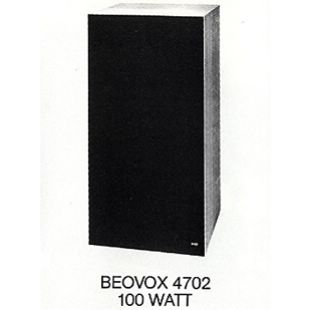

DIN power handling capacity 60 watts
Music power handling capacity 100 watts
Impedance 4 ohms
Frequency range 50 – 15,000 Hz
Harmonic distortion < 1 %
Sensitivity 3 watts
Net volume 30 litre Woofer
2 x 19cm
Mid-range 12,5cm
Tweeter 2,5cm
Crossover frequency 500 – 4000 Hz
Dimensions W x H x D 29 x 58 x 29cm
Weight 13 kg
Available documents are listed, if none are listed then please reach out to see if we have them.
Type | Language | Type | |
Service Manual | EN | BeoVox 4702 Service Manual |
Please let us know
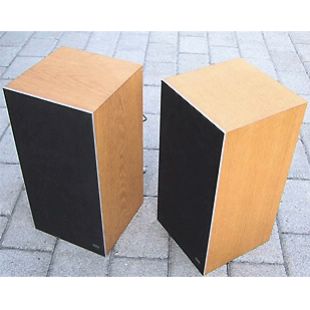
Beovox 2702 was a high-fidelity pressure chamber speaker in which good sound quality and discreet external appearance were skilfully combined. Frequency range 45-20.000 Hz, power handling capacity up to 25 watts RMS or 45 watts music. The bass unit has a 17,5cm diameter and the tweeter, 4cm.
Beovox 2702 met DIN high fidelity norms. The speakers were recommended as side speakers for ambio reproduction with Beosystem 4000.
Dimensions: height 41cm, width 20cm, depth 20cm
Finish: teak, rosewood or white
Available documents are listed, if none are listed then please reach out to see if we have them.
Type | Language | Type | |
Service Manual | EN | BeoVox 2702 Service Manual |
Please let us know
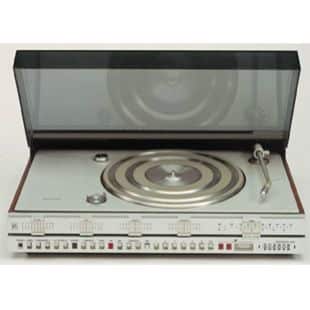
Beocenter 3500 was built upon the Beomaster 3000 and combined a top quality FM tuner, an automatic record-player and a powerful stereo amplifier. The tuner had six pre-set stations for instant selection, plus a large manual tuning scale. There was an illuminated tuning indicator and a signal-strength meter to assist easy, accurate tuning. The powerful amplifier produced 2 x 40 watts RMS of high-fidelity output and was equipped with switchable filters.
There was a comprehensive range of connection facilities including sockets for two pairs of loudspeakers, headphones and a tape recorder with monitoring. The record-layer was fully automatic with one master-control for operating all functions. You only have to select the control position applicable to the size of the record, and touch a button. Beocenter 3500 was an ideal, simple way of enjoying high quality sound from records and radio. It was fitted with a robust hinged dust cover which protects records during play.
In the high-fidelity amplifier section, emphasis was placed on specifications, frequency correction and connection facilities. The LOUDNESS feature permitted switching between an objective or a subjective linear reproduction and the LOW and I-II filter controls gave a sharper regulation of frequencies in addition to the normal bass and treble controls. The LOW filter helped reduce rumble resulting from poor records. The EH filter reduced hiss. There were sockets and push buttons for two pairs of loudspeakers. The headphone socket was on the receiver’s front. The tape connection facilitated AB monitoring. All input signals could be adjusted at the receiver’s base to give equal sound intensity on all programme sources. The FM section had six pre-set FM station selectors.
A light indicator assisted accurate tuning and an illuminated meter registered the signal strength of a station. The FM section was extremely sensitive (better than 1.4 uV I.E.C.) and harmonic distortion was a mere 0.4%. Field effect transistors, ceramic filters and integrated circuits were used. The built-in record-player was perfectly matched to the rest of the unit, from a specification point of view. The fitted pickup cartridge, the SP 10A (later SP 12A) had a spherical naked diamond and a stylus pressure of 1.2 grams. Frequency range was 20 – 25000 Hz ± 3 dB and distortion was lower than 1%. Wow and flutter was less than 0.09% and rumble was better than 60 dB.
The record player section was easy to operate: you simply selected the size of the record you intend to play – 7″, 10″ or 12″ – and press a button. The record-player automatically selected the correct speed – 33 or 45 rpm – and lowered the pick-up into the first groove. When the record ended, the pick-up arm returned to its resting place and the turntable switched off. The turntable and pick-up arm had a pendulum suspension which made the record-player section insensitive to vibrations. Deep furrows in the turntable made it easy to pick up records. A stroboscope and a spindle adaptor for centreless records was provided. Beocenter 3500 was fitted with a hinged dust lid which was easily removed by a sliding action.
Beocenter 3500 had an extra Phono input. This was a ‘hang over’ from the Beomasters of the time which allowed two Beograms to be connected to the music centre. However, Phono 2 needed an RIAA pre-amplifier as it required a line level input. This feature became ‘Tape 2’ in later models.
Power output:
2 x 40 watts RMS
2 x 75 watts music power
Speaker impedance 4 ohms
Distortion Less than 0.6% at 1000 Hz and 40 watts of power output on both channels simultaneously
Intermodulation Less than 0.6% at rated output, measured at 250 and 8000 Hz at amplitude ratio of 4:1 (DIN 45.403/3)
Channel separation Better than 45 dB at 1000 Hz and better than 30 dB between 250 Hz and 10,000 Hz. DIN 45 500/6. 2. 4. 1
Input separation Better than 60 dB at 1000 Hz and better than 45 dB between 250 Hz and 10,000 Hz. DIN 45 500/6
Bass control range +/- 17 dB at 50 Hz
Treble control range +/- 14 dB at 10,000 Hz
Balance control range Min 60 dB
Tuning range 87.5 – 104 MHz
Phono:
Speeds 33 1/3 and 45 rpm
Rumble Better than 60 dB (DIN B)
Wow and flutter Better than +/- 0.15 % peak value (DIN), corresponding to +/- 0.06 % RMS Pickup: Pickup SP 10 A
Stylus pressure 1.2 g (pond)
Power supply:
2401: 220V
2409: 120V
Power consumption 20 – 200 Hz
Dimensions H x W x D: 14.5 x 58 x 35cm
Weight 18 kg
Connections: Headphone Jack, tape DIN, extra record player DIN
Available documents are listed, if none are listed then please reach out to see if we have them.
Please let us know
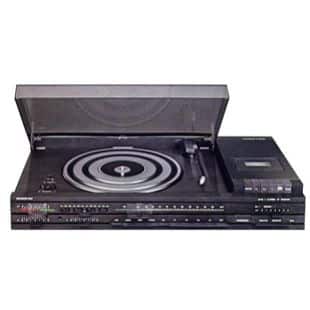
Amplifier:
Distortion 1000 Hz RMS 2 x 22 W / 4 ohms
2 x 19 W / 8 ohms
Music power 2 x 40 W / 4 ohms
2 x 25 W / 8 ohms
Speaker impedance: 4 ohms
Harmonic distortion: 1000 Hz 50 mW DIN: 45 500 < 0.1%
DIN 45 500 40 – 12,500 Hz: < 0.3%
Intermodulation DIN 45 500: < 1%
Frequency range +/- 1.5 dB DIN 45 500: 20 – 30000 Hz
FM tuner range: 87.5 – 108 MHz
Record Player: speeds 33 – 45 rpm
Pickup cartridge MMC 3000
Stylus Spherical diamond
Radius of curvature 15 µm
Frequency range 16 – 25000 Hz
Recommended stylus pressure 1.2 g
Automatic pickup movement Yes
Automatic speed selection Yes
Wow and flutter, DIN < +/- 0.12%
Wow and flutter, WRMS < +/- 0.06%
Rumble DIN unweighted > 37 dB
Rumble DIN weighted > 60 dB
Speed deviation < 0.1%
Speed control range > 3%
Dial for speed Stroboscope 120mm
Stylus pressure range 0 – 2.5 g
Anti-skating Yes
Motor Asynchronous
Drive system Idler wheel and belt
Turntable: 30 cm /1 kg
Tape Recorder:
Compact cassette C60 – C90
Tape head Super Permalloy
Dolby NR Yes
Iron oxide tape Yes
Chromium dioxide tape Yes
Indicator system Ligh emitting diodes
Stop at end of tape Yes
Wow and flutter, DIN < +/- 0.3 %
Speed deviation < +/- 1%
Fast forward and rewind 90 sec
Frequency range DIN chrome 20 – 13000 Hz
Signal-to-noise ratio Chrome > 53 dB
With microphone 75 µV / 10 Kohms
With Dolby Chrome > 61 dB
Erasure > 74 dB
Power supply:
110 – 130 – 220 – 240 V
Power consumption 20 – 170 W
Dimensions W x H x D: 66 x 13.6 x 35cm
Weight 16.9 kg
Available documents are listed, if none are listed then please reach out to see if we have them.
Type | Language | Type | |
Service Manual | EN | BeoCenter 3600 Service Manual |
Please let us know
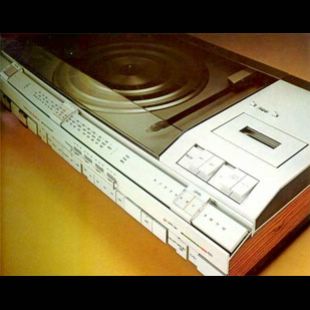
The AM radio covered long and medium wavebands. Outstanding reception quality and high selectivity was secured by an Automatic Gain Control circuit, active noise suppression and hybrid filters.
The FM tuner was highly sensitive. Four stations could be pre-set for subsequent instant recall. The hi-fi cassette deck had all the features and qualities normally expected only in a separate deck:
* 3-digit counter with memory function
* electronic tape stop at end of play
* Dolby B Noise Reduction
* chrome or normal tapes could be used
The super Permalloy tape head was hard-wearing and had a long, useful lifetime. The record player too was automated: all functions were controlled by a single button. The anti-skating device worked automatically too. Bang & Olufsen’s MMC 20 S pickup cartridge with a spherical diamond was an integral part of this unit. Two Beovox S40 speakers complete this system if this was your choice.
Please let us know
Available documents are listed, if none are listed then please reach out to see if we have them.
Please let us know
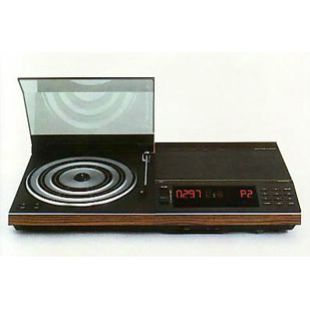
If space was limited in your home but you still wanted top-class sound reproduction from your hi-fi, Beocenter 5000 was the perfect answer. It offered high-technology performance from radio, records and cassettes, yet measured only 72 x 38 x 9,5cm. Each sound source could compete on merit with more expensive ‘separates’. The three high-performance components were integrated together into a single unit to give the best of all possible worlds.
The 2 x 40 watts RMS amplifier meant high power with minimal distortion – less than 0,1% at full output. The automatic record deck had a low-mass, low-inertia tone arm carrying an MMC 20E pickup and a precision-built electronic servo drive system for perfect speed accuracy. The cassette recorder was capable of the highest performance levels as it included Dolby Noise Reduction circuits, metal tape facility, automatic ferric/chrome selection, Sendust tape head and 4-digit electronic tape counter. The radio covered Long, Medium and FM bands, with five pre-set stations offering instant, press-button tuning.
Beocenter 5000 offered the same musical facilities and powerful 2 x 40 watts RMS output as Beocenter 7002. The two models were identical in the matter of sound quality too, but only the Beocenter 7002 had Bang & Olufsen’s very advanced timer-track location and remote control systems. The black anodised lid of its cassette compartment further differentiated Beocenter 5000 from the 7002.
Power output RMS DIN 2 x 40 watts / 4 ohms
2 x 30 watts / 3 ohms
Power output 20 – 20,000 Hz 2 x 30 watts / 4 ohms
2 x 25 watts / 8 ohms
Harmonic distortion -26 dB < 0.1%
Harmonic distortion < 0.1%
Intermodulation < 0.3%
Frequency range +/- 1.5 dB 20 – 30,000 Hz
Tuner: FM range 87.5 – 108 MHz
Record player:
MMC 20E Stylus elliptical diamond
Recommended tracking force 15 mN / 1.5 g
Tone arm Radial
Antiskating Integrated
Stylus pressure range 0-2 g
Speeds 33 – 45 rev. / min
Wow and flutter, DIN < +/- 0.09%
Wow and flutter, WRMS < +/- 0.045%
Rumble weighted > 65 dB
Rumble unweighted > 45 dB
Tape Recorder:
Compact cassette C60 – C90
Tape head Sendust
Noise reduction Dolby NR
Tape switch Auto ferro/chrom, manual metal
Wow and flutter < +/- 0.15 %
Speed deviation < +/- 1.5%
Fast forward and rewind C60 70 sec
Power supply:
110 – 130 – 220 – 240 V
Power consumption 20 – 250 W
Dimensions W x H x D: 72 x 9.5 x 38cm
Weight 16.5 kg
Available documents are listed, if none are listed then please reach out to see if we have them.
Please let us know
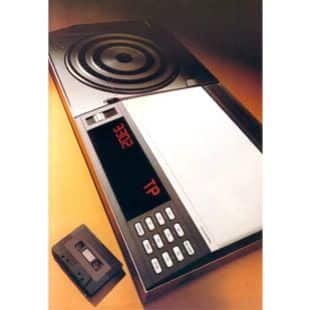
Beocenter 7000 upon its release, represented one of the most advanced hi-fi centres on the market. One touch produced instant music from a record, cassette tape or an FM or AM radio station. Illuminated symbols on the set’s communication panel confirmed instructions or rejected mistakes and kept you informed on the set’s operational status at all times.
in short, Beocenter 7000 offered two-way visual communication in high-fidelity.
The cordless remote control module put you in command of most of the functions from anywhere in the room. You could select any programme which would also switch on the set. You could regulate the volume – 2 x 40 watts RMS – make cassette recordings, and switch off the set. Comprehensive memory and timer facilities enabled you to program the set’s microcomputer to operate within a 24-hour period. It could record an important radio programme while you were out, and even instruct the Beocenter to wake you up with an early morning broadcast.
Each of Beocenter 7000’s three sound sources had the quality and performance level normally found in much more expensive separate units. The record deck had Electronic Servo Drive for absolute speed accuracy and its operation was fully automated. Stop, start or pause could be controlled via the remote control terminal. The cassette recorder had a Sendust record/replay head and a double-gap erase head that could even cope with metal tapes. You could locate any point on the tape simply by asking the set’s microcomputer to search for this required counter reading. The radio had facilities for pre-setting 5 FM and 1 AM stations which could then be selected instantly at the touch of a button.
Beocenter 7000 was designed by Jacob Jensen. In 1979 three more of the designer’s creations for Bang & Olufsen were included in the Design Collection of the Museum of Modern Art in New York including the Beocenter 7000 music system.
Continuous power output per channel 30 W at 4 ohms
30 W at 8 ohms
Rated band width 20 – 20,000 Hz
Total harmonic distortion < 0.15%
IHF intermodulation < 0.15%
FM tuner range 87.5 – 108 MHz
Record player:
Pickup MMC 20 EN Stylus elliptical naked diamond
Recommended stylus pressure 12 mN / 1.2 g
Frequency range 20 – 20,000 Hz +/- 2 dB
Wow and flutter DIN < +/- 0.09 %
Rumble weighted > 65 dB
Rumble unweighted > 45 dB
Tape recorder:
Wow and flutter < +/- 0.09 %
Speed deviation < +/- 1.5 %
Frequency range chrom-metal 30 – 16,000 Hz
Signal-to-nosie ratio Metal Dolby NR > 66 dB
Metal > 59 dB
Chrome Dolby NR > 64 dB
Chrome > 57 dB
Power supply 1801: 220V
1803: 120V
Power consumption: 20 – 250 W
Dimensions W x H x D: 72 x 9.5 x 38cm
Weight 16.5 kg
Available documents are listed, if none are listed then please reach out to see if we have them.
Type | Language | Type | Date | Type | |
Service Manual | EN | 1801 | BeoCenter 7000 Service Manual |
Please let us know
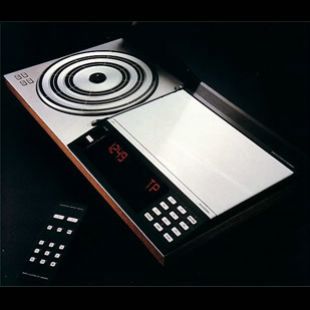
Illuminated symbols on the set’s communication panel confirmed your instructions or rejected mistakes, and kept you informed of the set’s operational status at all times. In short, Beocenter 7002 offered two-way communication in high fidelity.
The cordless remote control module put you in command of all functions from your chosen listening position. Select any programme; this action also switched the set on. Regulate the volume level – there were 2 x 40 watts RMS at your disposal. Make cassette recordings. Or switch off the set – all without leaving your chair.
Comprehensive memory and timer facilities enabled you to programme the set’s microcomputer to operate any function at a given time within a 24-hour period. It could record an important radio programme while you were away from home. You could even instruct the Beocenter to wake you up with an early morning broadcast.
Each of the Beocenter 7002’s three sound sources had a high quality and performance level normally found only in much more expensive separate units.
The record deck had electronic Servo Drive for absolute speed accuracy and its operation was fully automated. Stop, start or pause by remote control. The cassette recorder had a Sendust record/replay head and a double-gap erase head that could even cope with metal tapes. You could locate any point on the tape simply by asking the set’s microcomputer to search for this required counter reading. The radio had facilities for pre-setting 5 FM and 1 AM stations which could then be selected instantly at the touch of a button.
Beocenter 7002 offered the same musical facilities and powerful 2 x 40 watts RMS output as Beocenter 5000. The two models were identical in the matter of sound quality too, but only the Beocenter 7002 had Bang & Olufsen’s very advanced timer-track location and remote control systems. The black anodised lid of its cassette compartment further differentiated Beocenter 5000 from the 7002.
Continuous power output per channel 30 W at 4 ohms
30 W at 8 ohms
Rated band width 20 – 20,000 Hz
Total harmonic distortion < 0.15%
IHF intermodulation < 0.15%
FM tuner range 87.5 – 108 MHz
Record player:
Pickup MMC 20 EN Stylus elliptical naked diamond
Recommended stylus pressure 12 mN / 1.2 g
Frequency range 20 – 20,000 Hz +/- 2 dB
Wow and flutter DIN < +/- 0.09 %
Rumble weighted > 65 dB
Rumble unweighted > 45 dB
Tape recorder:
Wow and flutter < +/- 0.09 %
Speed deviation < +/- 1.5 %
Frequency range chrom-metal 30 – 16,000 Hz
Signal-to-nosie ratio Metal Dolby NR > 66 dB
Metal > 59 dB
Chrome Dolby NR > 64 dB
Chrome > 57 dB
Power supply 1801: 220V
1803: 120V
Power consumption: 20 – 250 W
Dimensions W x H x D: 72 x 9.5 x 38cm
Weight 16.5 kg
Available documents are listed, if none are listed then please reach out to see if we have them.
Please let us know
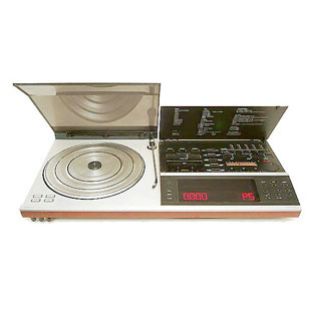
Beocenter 7007 (also known as Beosystem 7007)
Top quality sound and maximum listening comfort were the main features of this integrated hi-fi system. Records, radio, cassette tapes and a 2 x 40 watts RMS stereo amplifier could all be controlled from anywhere in the room using the slim remote handset. Without moving more than a finger you could select any sound source, adjust volume level, fast wind the tape and even make recordings. This supreme ease of operation was made possible by microcomputer technology. In addition, there were two user-programmable microcomputers which allowed you to make unattended recordings at any time within a 24-hour period, or to play any sound source automatically at a pre-selected time – day after day, if you wished.
A further advantage was easy access to cassette recordings: just key in the appropriate counter reading (address) and the cassette would fast wind to the required passage of music. Ferric, chrome or metal tapes could all be used and Dolby B Noise Reduction was included to ensure clean, hiss-free recordings.
The automatic record deck had an ultra-lightweight arm carrying the MMC 4 pickup cartridge. The radio section covered Long, Medium and FM bands with facilities for pre-setting 6 favourite stations.
The recommended speakers were the Beovox S55 . Speaker pedestals or the SC70/ SC77 hi-fi cabinet could be added optionally if required.
Continuous power output per channel: 30 W / 4 ohms; 30 W / 8 ohms
Rated bandwidth: 20 – 20,000 Hz
Total harmonic distortion: < 0.15 %
IHF Intermodulation: < 0.15 %
Wideband damping factor: > 45
Usable sensitivity stereo: 18 dBf-2.2 µV / 75 ohms
Signal-to-noise ratio at 65 dBf stereo: > 70 dB
Pickup: MMC 4 (Stylus: elliptical diamond)
Frequency range: 20 – 20,000 Hz +/- 2.5 dB
Channel separation: > 22 dB
Recommended stylus pressure: 12 mN / 1.2 gram
Compliance: 25 um / mN
Effective tip mass 0.4 mg
Wow and flutter, WRMS: < +/- 0.045 %
Rumble weighted: > 65 dB Tapehead: Sendust
Noise reduction: Dolby NR B
Tape switch Auto ferro/chrom, Manual metal
Wow and flutter: < +/- 0.15 %
Frequency range chrome – metal: 30 – 16,000 Hz
Signal-to-noise ratio: Metal Dolby NR > 68 dB
Chrome Dolby NR > 66 dB
Power supply: 1811 220V
1813 US 120V
1814 J 100V
1815 AUS 240V
1817 GB 240V
1818 CDN
1819 D 220V
Power consumption 20 – 250 W
Dimensions W x H x D: 72 x 9.5 x 39 cm
Weight: 16.5 kg
Connections: Headphone jack
Available documents are listed, if none are listed then please reach out to see if we have them.
Please let us know
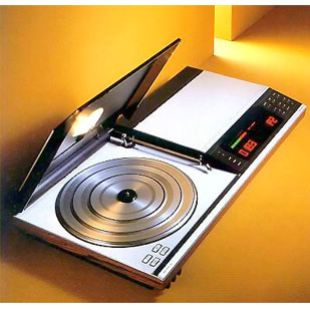
With the Beolink® system – around which Beocenter 7700 was based – you could enjoy and control you music system in several rooms. From acorns great oak trees spring, and most of the the current (2002) range of TV and hi-fi systems can be equally controlled to give you ’round the house music’ using the latest MasterLink system.
The very advanced (for its time) Beocenter 7700 system brought an entirely new range of possibilities to the serious music-lover. For the very first time ever, round-the-house hi-fi became an option, in whichever room you wanted to listen to it.
Beocenter 7700 featured Long, Medium and FM radio, automatic record deck, microcomputer controlled cassette recording and 2 x 40 watts RMS stereo amplifier. Two user-programmable 24-hour timers were included, and all sound sources are accessible by infra-red remote control.
From this comprehensive and desirable foundation, it was possible to build up (either immediately, or room by room) a sound system that could be enjoyed and operated from anywhere in the house ( a forerunner to the later Beolink® system).
But in addition, it also had three digital read-out panels on which your instructions were confirmed every time you pressed a button. So you had your means of “talking to” your Beocenter 7700, and it had a means of “talking to” you – right there in your hand.
Your instructions were carried to the Beocenter’s microcomputer by infra-red light, and confirmatory signals were returned to the remote control Terminal in the same way – in a fraction of a second.
This two-way communication could be extended to other rooms by fitting those rooms with a pair of speakers and an electronic Master Control Link, all available as optional accessories. When you wanted to listen to music or radio in a room away from the Beocenter, the remote control Terminal was taken with you. By directing it at the Master Control link (which you had fixed on the wall or on a shelf) in just the same way as you would normally direct it towards the Beocenter, you could control all primary functions and receive confirmation that the Beocenter was doing what you want.
The Master Link equipment could be fitted in up to four different rooms, and you could choose which speakers were to play and which were to be silent. It was like having a complete, top-quality hi-fi system in every room, but paying for only one (plus as many loudspeakers and Master Links as you needed). You could, if you wished, buy additional remote control Terminals if you didn’t want to carry one around the house. But this was not strictly necessary.
Beocenter 7700 offered top quality sound from records, radio and cassettes. Operation was fast, easy and foolproof because of a built-in microcomputer which blocked mistakes, automating many boring, repetitive operations – like switching off one sound source before switching on another. Two timers, each with a 24-hour memory and automatic repeat function, allowed you to record or play any programme at specific times – day after day if you wished. The digital clock could be displayed or not – it was up to you.
You could pre-set 6 favourite FM radio stations, or 5 FM and one AM (Long or Medium wave) for instant press-button recall – either by direct or remote control.
The cassette section had many advanced features to make recording easier and more accurate. Replay, too – it was necessary just to key-in the appropriate counter reading and the cassette would fast wind to any point on the tape. It was as easy as finding a particular track on a record.
Metal, ferric and chrome tapes could be used, and the Dolby Noise Reduction circuits ensured clean, hiss-free sound.
The record deck was fitted with the (then) very latest type of tone arm and miniature MMC 3 cartridge. This pick-up carried a tiny naked elliptical diamond and weighed only 1.6 grams. It had superb tracking ability and ensured the minimum of record wear.
The safe handling of records was also the idea behind the turntable light – fitted inside the hinged lid – which switched on automatically whenever the lid was opened, and stayed alight as long as the deck was in operation.
Beocenter 7700 was available in natural teak or rosewood finish. It measured 72cm wide x 9.5cm high (37.5cm with the lid open) x 38cm deep and could be accommodated in either SC.50 or SC.70 System Cabinet, available separately.
Your choice of loudspeakers for use with Beocenter 7700 was really a matter of listening and comparing the various Beovox models. Different households had different requirements – in size, in quality and in cost. Fortunately, with the Beovox range the choice was a wide one. Advice on speakers for the Beocenter 7700 included Beovox C40, C75, S45, S55 and S80.
Beocenter 7700 was introduced as a completely new way of operating a hi-fi system. A way which gave individuals the freedom to enjoy top quality sound all over the house; at the same time to control the music from anywhere in any room.
This was the world’s first high fidelity system that could be operated from another room. With the Beocenter 7700’s master Control Panel and and optional Master Control Link, you could control radio, record deck, cassette recorder and stereo amplifier even though you were in the kitchen or bedroom and the set itself was in the lounge.
So when you want music in another room, don’t move the hi-fi – just move the music!
A Master Control Panel (above) was supplied with every Beocenter 7700. It was used just like an ordinary remote control handset when you were listening in the lounge, close to your hi-fi system. It let you operate all sound sources and adjust volume levels without moving from the comfortable armchair.
Master Control Link was an optional accessory, like the additional loudspeakers you needed in order to enjoy your music in other rooms. The Link equipment consisted of two units – a discreet black box containing a mass of sophisticated electronic circuitry (which could be fitted out of sight behind furniture etc.), and a transceiver unit that was placed on a shelf or wall where it could pick up the infra-red signals from your Master Control Panel. The transceiver unit also let you switch the speakers in this room on or off, and gave access to programmes that were due to be played via the Beocenter’s automatic timers.
You could buy extra stereo speakers and Master Control links for one, two or three additional rooms, as well as enjoying the hi-fi system itself which you probably installed in the living room or the lounge.
The Master Link equipment was connected by cable ‘in series’, i.e. only the first extra room is connected direct to the Beocenter; the second extra room was connected to the first and so on, so wiring was kept to a minimum. And you could add each room one by one – as your needs changed or your budget allowed.
Power output RMS DIN: 2 x 40 W / 4 ohms
Harmonic distortion: <0,1%
Intermodulation: <0,3%
Frequency range + / – 1,5 Db: 20 – 30000 Hz
FM sensitivity stereo 46dB: <25 microvolts/75 ohms
FM harmonic distortion: <0,2%
FM Stereo channel separation > 35dB
AM sensitivity 20dB LW/MW: < 100/80 microvolts
Record player – pickup: MMC4
Recommended tracking force: 12mN/1.2g
Speeds: 33 – 45 rpm
Wow & flutter DIN: <+/- 0.09%
Rumble weighted: >65dB
Rumble unweighted: >45dB
Tape recorder – Wow & flutter DIN: <+/- 0,15%
Speed deviation: <+/- 1,5%
Fast forward & rewind: 70 sec
Frequency range metal/chrome: 30 – 16KHz Signal-to-noise ratio Metal Dolby NR: >66dB
Chrome Dolby NR: >64dB
Ferro Dolby NR: >62dB
Metal: >59dB
Chrome >57dB
Power supply: 110-130-220-240 V
Frequency/consumption: 50-60 Hz/250V
Finishes: teak or rosewood
Dimensions W x H x H/weight: 72 x 9,5 x 38cm/16,5kg
Available documents are listed, if none are listed then please reach out to see if we have them.
Please let us know